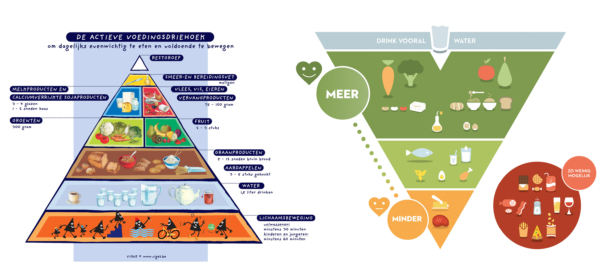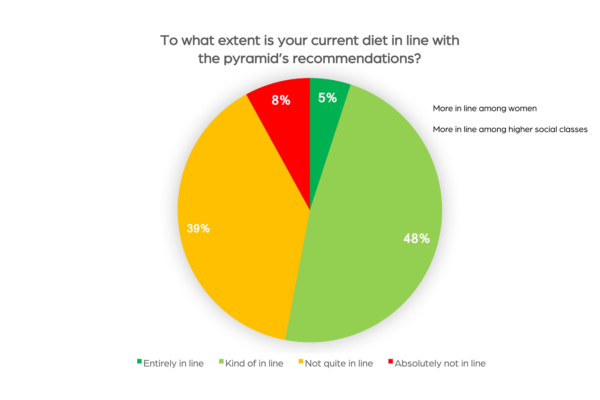Overall
Overall, we can state that approximately 2/3 of Belgians are aware of the new food pyramid. In Flanders that figure is markedly higher, namely 85%. For young people under the age of 35, awareness is lower; only 56% know that a new food pyramid has been launched.
Almost 70% of Belgians see a food pyramid as a useful guideline. Some of the arguments:
“It's perhaps not correct in all details, but with one quick glance you can see clear do’s and don’ts around food.
“It's very useful, for example for children or people with low skills, who do not search for or read long articles”.
Unlike the previous version, the new pyramid does not state any portions, and this change has been positively received by no less than 68% of Belgians.
Almost 70% of Belgians consider the food pyramid a useful guideline.
Experts
To draw up the new pyramid, a panel of experts made up of not only nutritional experts and human movement scientists, but also psychologists and experts from the government and organisations such as ‘Kind en Gezin’ was consulted. For the first time, stakeholders such as FEVIA (the food industry) and VLAM (Flanders' Agricultural Marketing Board / Vlaams Centrum voor Agro- en Visserijmarketing) were not involved. No less than 75% of Belgians agreed with this approach.
Here is a taster of the arguments made:
“Stakeholders often have other motives than health. You would expect that this is different to an expert panel.”
“You can often find figures and studies to support any viewpoint. You would expect stakeholders to pick out the figures that make their point and so seem to provide scientific backing. (Hopefully) an expert panel will take an overall view and weight up the pros and cons of the evidence.”
The food industry itself has reacted quite negatively to the new food pyramid. They state that there are no unhealthy products, just unhealthy diets, and that all foodstuffs have a place in a balanced diet. The food sector is particularly negative about the recommendation to eat less red meat and processed meat, and the explicitly negative vision of the foodstuffs that are in the red circle (while previously they were in the ‘rest group’ within the pyramid).

When Belgians were asked for their opinion on the food industry's point of view, half of them admitted to agree with it. The main arguments for this point of view are that everyone has its own metabolism, or that it is indeed variety that is relevant, as "even the most healthy things can be unhealthy in excess".
The counter-arguments are that the food industry mainly considers its own interests, and objectively speaking certain foods can be seen as either healthy or unhealthy.
Sustainability
For the first time the sustainability factor was included, i.e. the environmental impact resulting from the production of a certain foodstuff. No less than 72% of Belgians thought that this was a good idea.
“Sometimes we grab something off the shelves without properly considering what this choice means for our planet. You can still decide for yourself whether you find the argument relevant or not, but at least you have an idea. We cannot continue to consume the planet as we are doing, and when we spread this message, the first step is behavioural change.”
However, some people remained critical: “Even if we as consumers take this into consideration, it's just a drop in the ocean. It would make more sense to educate the industry about this or look at the superpowers.”
Including sustainability was received positively by no less than 72% of Belgians.
How healthy do we eat?
Our survey shows that the current diet of more than 50% of Belgians is more or less in line with the pyramid’s recommendations (lots of fruit and vegetables, grains and fibres, natural products, less fish and proteins, little red meat, occasional processed products, sugars and saturated fats), and by and large Belgians know how to distinguish between healthy and unhealthy food.
(*) Find out the major differences
The foodstuffs are no longer ranked in terms of the nutrients that they provide, but in terms of their effect on our health.
For example, red meat, poultry, eggs, fish, legumes and nuts were previously all in the same group, 'high-protein products'. In the new pyramid they have been separated. Nuts and legumes get a separate, more prominent place, and distinctions have been made between red meat, poultry and processed meats, as they have different effects on our health. So ‘’charcuterie’ and processed meats are not in the pyramid, but in the red circle next to sugars, fats and soft drinks.
In addition, not all fats are the same. As much as possible, we should replace saturated fatty acids, of which butter contains a lot, with unsaturated fatty acids. Therefore vegetable oils are no longer in the same group as butter.
For the ranking, the environmental impact of the foodstuffs has also been taken into consideration. Healthy food which is less damaging for the environment has been given priority.
While the previous pyramid included an exercise layer, a separate exercise pyramid has now been made.





